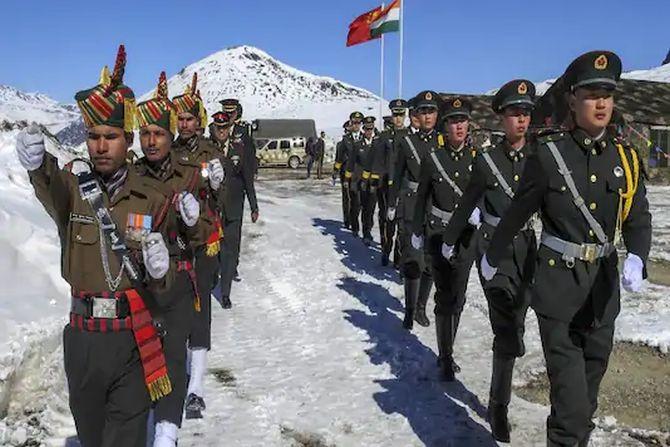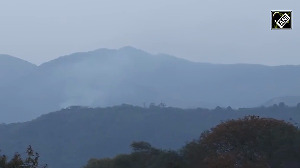Chinese military removed temporary infrastructure and continued gradual withdrawal of troops from face-off sites in Hot Springs and Gogra in eastern Ladakh for the second consecutive day on Tuesday, and the Indian Army is keeping a strict vigil on their rearward movement, government sources said.

Gogra and Hot Springs are among the key friction points where the two armies were in an eyeball-to-eyeball situation for the last eight weeks.
The sources said the mutual disengagement of troops at the two friction points is likely to be completed within two days, and that there has been 'substantial' withdrawal of forces by Chinese military from the areas.
The disengagement process began on Monday morning after a nearly two-hour telephonic conversation between National Security Advisor Ajit Doval and Chinese Foreign Minister Wang Yi on Sunday during which they agreed on an expeditious withdrawal of troops from the area.
Doval and Wang are Special Representatives for the boundary talks.
The sources said the Indian Army is not lowering its guard in view of the disengagement process in the area and will continue to maintain high-level of alertness to deal with any eventualities.
They said the two two Armies are expected to hold further talks later this week after the first phase of disengagement process is completed.
As per the decisions arrived at corps commander-level talks on June 30, the two sides would create a minimum buffer zone of three kilometer in most of the areas where they were locked in a standoff.
"There has been substantial withdrawal of Chinese troops from Hot Springs and Gogra. The Chinese mliitary has dismantled temporary infrastructure too in the areas," said a source.
The Chinese military has already removed tents and withdrew its personnel from patrolling point 14 in Galwan Valley, the sources said adding the Indian Army is carrying out a thorough verification of the Chinese pull back.
On the situation in Pangong Tso, they said a 'marginal thinning out of troops' has been observed in the area.
The Indian and Chinese armies are locked in the bitter standoff in multiple locations in eastern Ladakh for the last eight weeks.
The tension escalated manifold after the killing of 20 Indian soldiers in Galwan Valley on June 15.
The Chinese side also suffered casualties but it is yet to give out the details.
According to an American intelligence report the number of casualties on the Chinese side was 35.
Both sides have held several rounds of diplomatic and military talks in the last few weeks to ease tension in the region.
However, there was no visible sign of any end to the standoff till Sunday evening.
Sources said the breakthrough was achieved at the Doval-Wang meeting.
On June 30, the Indian and Chinese armies held the third round of Lt General-level talks during which both sides agreed on an 'expeditious, phased and step wise' de-escalation as a 'priority' to end the standoff.
In the talks on June 22, the two sides arrived at a 'mutual consensus' to 'disengage' from all the friction points in eastern Ladakh.
The first round of the Lieutenant General talks was held on June 6 during which both sides finalised an agreement to disengage gradually from all the standoff points beginning with Galwan Valley.
However, the situation deteriorated following the Galwan Valley clashes as the two sides significantly bolstered their deployments in most areas along the LAC.
On Friday, Prime Minister Narendra Modi made a surprise visit to Ladakh during which he said the era of expansionism is over and that the history is proof that 'expansionists' have either lost or perished, in comments which were seen as a clear message to China that India is not going to back off and would deal with the situation with a firm hand.
Tensions had escalated in eastern Ladakh around two months back after around 250 Chinese and Indian soldiers were engaged in a violent face-off on May 5 and 6. The incident in Pangong Tso was followed by a similar incident in north Sikkim on May 9.











 © 2025
© 2025